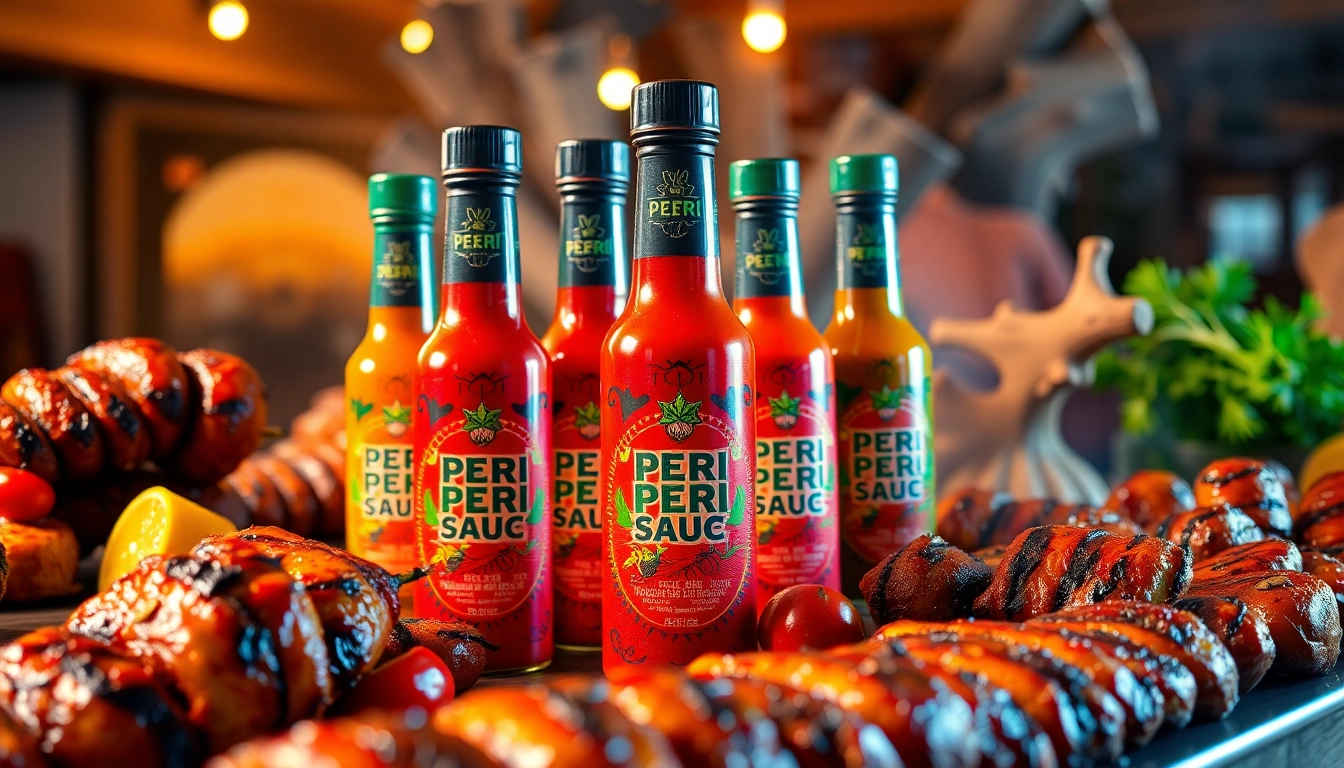Introduction: The Rise and Significance of Flavored Sauces in Global Cuisine
In today’s vibrant culinary landscape, sauces play a pivotal role in elevating dishes, adding depth, and defining flavors. Among these, Peri Peri Sauce has garnered international acclaim for its bold, spicy, and tangy profile. Its versatility makes it a favorite across continents, making it a staple in both home kitchens and professional kitchens worldwide. Understanding the nuances of Peri Peri Sauce—from its origins to how it is crafted—is essential for chefs, food entrepreneurs, and food lovers eager to incorporate this fiery condiment into their culinary repertoire.
Understanding Peri Peri Sauce: Origins and Key Ingredients
Historical background and regional influences
Peri Peri Sauce, also known as Piri Piri or Pili Pili, traces its roots to the Portuguese explorers and their colonies in Africa, particularly Mozambique and Angola. The term ‘Peri Peri’ is derived from the Swahili word ‘piri piri,’ meaning ‘pepper pepper.’ This fiery sauce exemplifies the rich intercultural melding, combining African chili peppers, Portuguese culinary techniques, and indigenous ingredients. Over centuries, it evolved from a simple chili marinade to a world-renowned flavor enhancer.
Main ingredients that define authentic Peri Peri flavor
The hallmark of authentic Peri Peri Sauce lies in its fiery chili peppers, traditionally involving African bird’s eye chilies, which lend the sauce its distinctive heat. Alongside the chilies, key ingredients include garlic, lemon juice, vinegar, paprika, and a blend of herbs and spices like oregano and bay leaves. The balancing act between heat, acidity, and aromatic herbs defines its complexity. High-quality ingredients, especially fresh chili peppers and organic spices, are essential for crafting an authentic, flavorful Peri Peri Sauce.
Differences between homemade and commercial Peri Peri sauces
Homemade Peri Peri sauces often have a fresher, more vibrant flavor profile, allowing tailored spice levels and ingredient choices. They tend to be free from preservatives and artificial additives. Conversely, commercial versions prioritize consistency, shelf-stability, and mass production, often incorporating stabilizers, preservatives, and flavor enhancers. While commercially produced sauces offer convenience, artisanal recipes—like those from Spice Nest—maintain authenticity by using premium ingredients and strict quality controls to ensure superior taste and safety.
Steps to Make Peri Peri Sauce at Home
Choosing the right chili peppers and spices
The foundation of a great Peri Peri Sauce starts with selecting the proper chili peppers. African bird’s eye chilies are traditional, offering a distinctive heat and fruity flavor. Alternatively, some recipes incorporate Thai chilies or cayenne for milder or different heat profiles. Freshness is key; dried or older peppers may lack the vibrant flavor necessary. Complement these with quality spices like smoked paprika, oregano, and cumin. Fresh garlic and lemon juice are also critical components that bring brightness and depth to the sauce.
Preparing the base and blending techniques
The preparation involves blending the chilies, garlic, spices, lemon juice, and vinegar into a smooth or slightly chunky paste, depending on preference. It’s advisable to roast or char some ingredients—like the chilies and garlic—for added smoky richness. Using a high-speed blender ensures a homogeneous texture. Straining the mixture can yield a smoother sauce, while leaving some pulp adds texture and intensity.
Adjusting spice levels and consistency for perfect taste
Customizing the heat level involves adding more or fewer chilies. Start with a small quantity and taste-test along the way, as chilies vary in spiciness. The consistency can be thinned with more lemon juice or vinegar or thickened by simmering the sauce gently for a few minutes. Balancing acidity and heat is vital; often, adding honey or a touch of sugar can mellow overly aggressive spice or acidity, creating a harmonious flavor profile.
Commercial Production of Peri Peri Sauce for Retail
Ensuring quality control and consistency
Manufacturers like Spice Nest emphasize stringent quality control measures, sourcing high-grade raw ingredients, and adhering to global food safety standards. Consistency is achieved through standardized recipes, precise blending equipment, and controlled processing environments. Regular laboratory testing for microbial safety, pH levels, and flavor consistency ensures that each batch meets top-tier quality criteria, which is crucial for consumer trust and brand reputation.
Packaging innovations to preserve freshness
To extend shelf life and preserve flavor, advanced packaging solutions such as vacuum-sealed bottles, air-tight glass jars, and tamper-evident pouches are employed. These methods prevent contamination, oxidation, and spoilage. Additionally, incorporating UV-blocking materials and employing aseptic filling techniques further safeguard the product’s freshness and flavor integrity during transportation and storage.
Market trends and consumer preferences in Peri Peri sauces
Current market insights reveal a rising consumer demand for spicy and exotic flavors, especially among millennials and health-conscious buyers seeking natural, preservative-free options. Organic Peri Peri sauces with transparent ingredient lists are gaining popularity. Flavored variations—like smoky, lemon, or garlic-infused Peri Peri—expand appeal across diverse cuisines. Understanding these trends enables manufacturers like Spice Nest to innovate and cater to evolving tastes, expanding their global footprint effectively.
Using Peri Peri Sauce to Elevate Your Dishes
Marinades and grilling tips for maximum flavor
Peri Peri Sauce excels as a marinade for chicken, seafood, and even vegetables. To maximize flavor, marinate your proteins for at least 2-4 hours, allowing the spice to penetrate deep. For grilling, brush the sauce onto the ingredients during cooking, and let the smoky aroma permeate the dish. The sauce’s acidity helps tenderize meat, while its heat adds a fiery kick.
Pairing Peri Peri sauce with various cuisines
Its versatility allows seamless pairing with dishes ranging from Portuguese and African to modern fusion cuisine. Use it as a dip, drizzled over salads, in sandwiches, or even stirred into stir-fries for an instant flavor upgrade. Its bold character complements creamy elements like yogurt or coconut milk, balancing spice with richness for a diverse array of dishes.
Create signature dishes to boost restaurant menus
Innovative chefs incorporate Peri Peri as a core ingredient in signature recipes, such as spicy peri peri grilled wings, peri peri pasta, or infused finishing sauces on steaks. Offering unique Peri Peri-infused options differentiates brands and attracts curious consumers. Consistency in the sauce’s flavor becomes critical, which is increasingly achievable through professional production standards like those at Spice Nest, ensuring every plate delivers the same fiery satisfaction.
Measuring Success: Marketing and Selling Peri Peri Sauce
Effective branding and positioning strategies
Positioning your Peri Peri Sauce as a premium, authentic, and versatile flavor condiment enhances market appeal. Emphasize its rich cultural heritage, natural ingredients, and health benefits—such as being low in preservatives if applicable. Packaging design should reflect boldness and authenticity, aligning with consumer preferences for premium and artisanal products.
Utilizing online platforms and social media
Leverage social media campaigns highlighting recipes, user-generated content, and culinary demonstrations to boost engagement. Partnering with food bloggers and chefs can generate buzz and showcase versatility. E-commerce platforms and brand websites should feature detailed product information, usage tips, and customer reviews to facilitate online sales and brand loyalty.
Analyzing sales data for continuous improvement
Regular monitoring of sales metrics, customer feedback, and market trends allows brands to refine their offerings, introduce new variants, and optimize marketing campaigns. Data-driven insights help identify gaps, understand regional preferences, and enhance product development, driving growth and consumer satisfaction.



